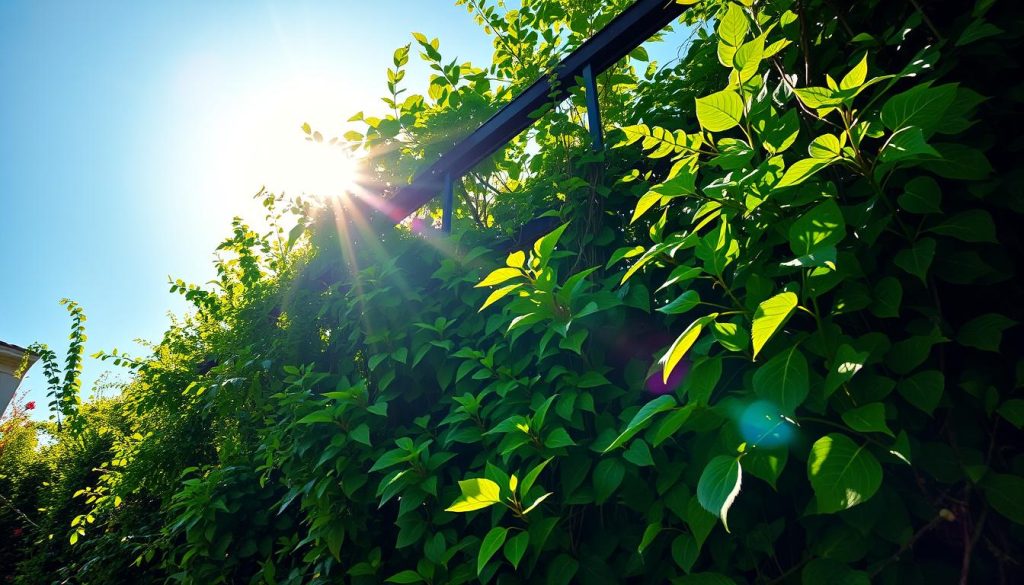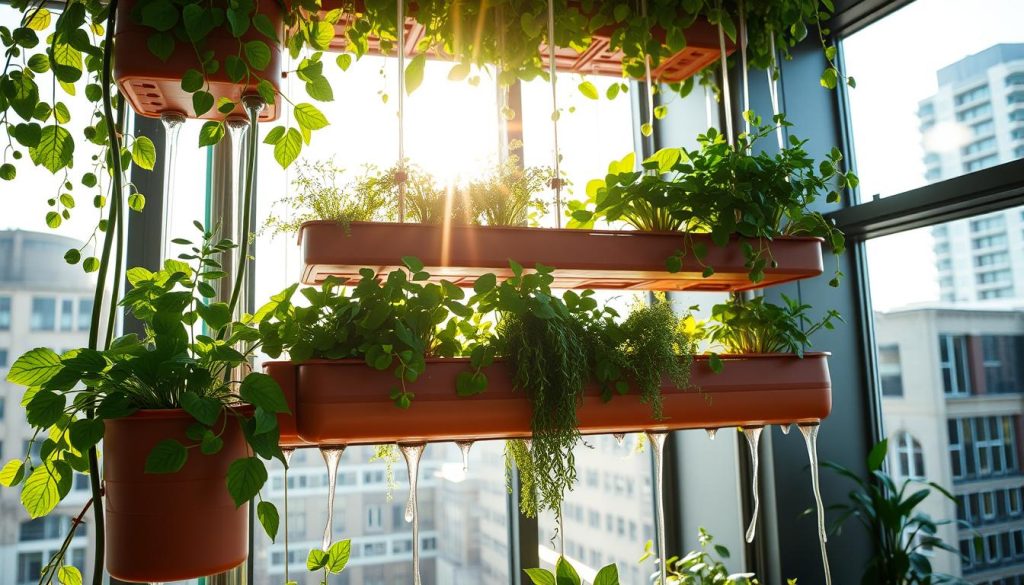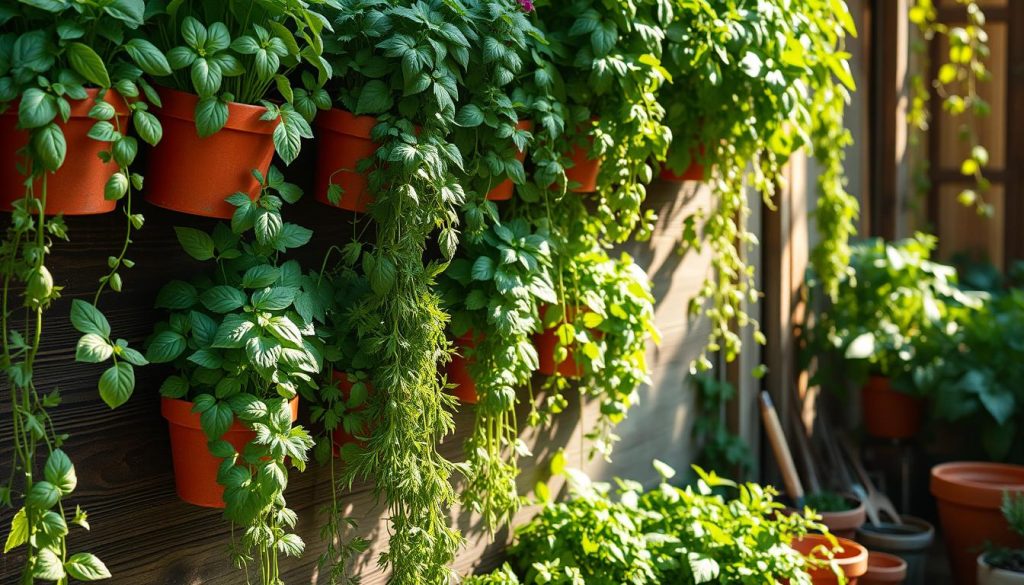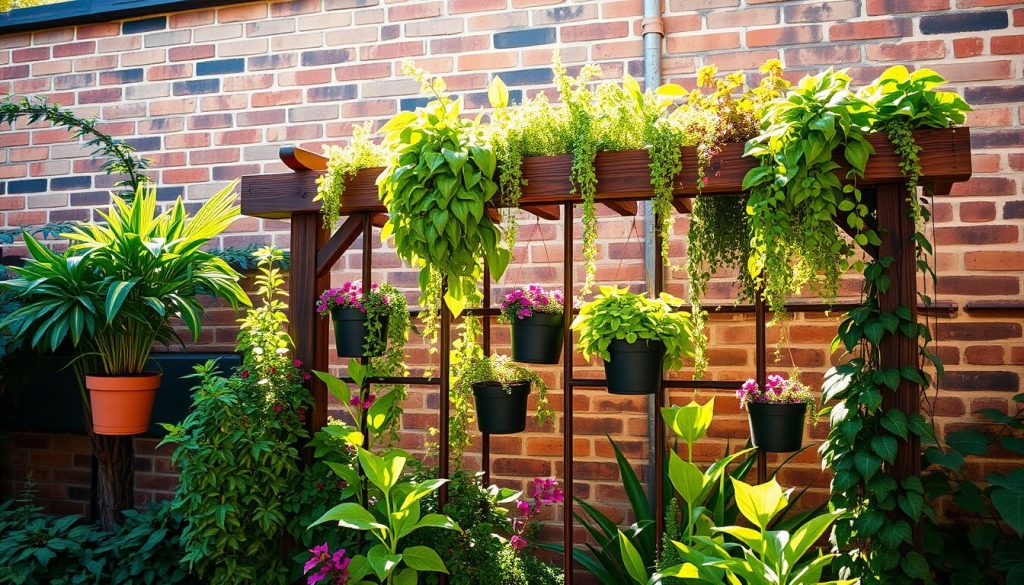Ever dreamed of having a lush garden but feel cramped by your tiny balcony or limited yard space? I’ve been there too. That’s why I’m thrilled to introduce you to the world of vertical gardening for beginners. This innovative approach to urban gardening has changed the game for small space enthusiasts like me.
Vertical gardening lets you grow plants upward instead of outward. It’s perfect for city dwellers, apartment renters, or anyone looking to maximize their growing area. I’ve discovered that this method of small space gardening not only saves room but adds a stunning green element to any wall or fence.
In this guide, I’ll share my journey into vertical gardening and show you how easy it is to get started. From choosing the right plants to setting up your first living wall, we’ll explore all the basics of this space-saving technique. Get ready to transform your small outdoor area or indoor space into a thriving vertical garden!
What is Vertical Gardening and Why It Matters
Vertical gardening is a big deal for city folks and those who love saving space. It lets you grow plants up instead of out, making the most of small spots. I’ve found it’s perfect for my tiny balcony.
Benefits of Vertical Gardening
Vertical gardening has lots of perks:
- Maximizes space in small areas
- Improves air quality indoors and outdoors
- Adds visual appeal to plain walls
- Increases privacy in urban settings
Environmental Impact of Growing Up
Vertical gardens are good for our planet. They cool buildings and help local wildlife. This makes cities greener and more livable.
Perfect for Beginners
I always suggest vertical gardening to newbies. It’s easy to start and shows results fast. It’s less scary than regular gardening, and you’ll want to keep growing.
Vertical gardening is great for small spaces or just for fun. It brings nature into your life. It’s a smart choice for city living and a fun hobby for garden lovers.
Essential Tools and Supplies for Vertical Gardening
Starting a vertical garden is exciting for beginners. The right tools and supplies are key. Let’s look at what you need to start your garden growing up!
Must-Have Gardening Tools
For vertical planting, you’ll need some basic tools:
- Pruning shears for trimming plants
- Hand trowel for planting and digging
- Watering can or hose with a spray nozzle
- Gloves to protect your hands
Vertical Garden Frame Options
Choosing the right frame is crucial for vertical gardening. Here are some options:
- Wooden pallets repurposed as planters
- Metal grid systems for a modern look
- Pocket planters that hang on walls
- Tiered plant stands for balconies or patios
Selecting the Right Soil and Fertilizers
Using the right soil mix is a key tip for beginners. Choose a lightweight, well-draining potting mix for containers. For fertilizers, pick a balanced, slow-release option to keep your plants healthy all season.
With these essentials, you’re ready to start your vertical gardening journey. Remember, the right tools and supplies will help you succeed in your new green space!
Choosing the Right Location for Your Vertical Garden
Finding the perfect spot for your vertical garden is key to success. As a beginner in vertical gardening, I’ve learned that location can make or break your plants’ growth. Let’s explore the crucial factors to consider when setting up your small space garden.
Sunlight Requirements for Plants
Plants need sunlight to thrive. In vertical gardening, it’s vital to match your plants with the right light conditions. I’ve found that most vegetables and herbs require at least 6 hours of direct sunlight daily. For indoor gardening, place your vertical setup near a south-facing window for maximum light exposure.

Indoor vs. Outdoor Vertical Gardens
Deciding between indoor and outdoor gardens depends on your space and climate. Indoor vertical gardens offer year-round growing and protection from harsh weather. Outdoor setups give plants natural sunlight and rain but need more care during extreme temperatures.
| Factor | Indoor Vertical Garden | Outdoor Vertical Garden |
|---|---|---|
| Light Control | Easy with grow lights | Dependent on natural sunlight |
| Temperature | Stable year-round | Varies with seasons |
| Pest Management | Fewer pest issues | More prone to pests |
| Space Efficiency | Excellent for small apartments | Great for balconies and patios |
Wind Protection and Drainage Considerations
For outdoor vertical gardens, wind protection is crucial. I use trellises or walls to shield my plants from strong gusts. Proper drainage prevents root rot in both indoor and outdoor setups. I ensure my vertical structures have adequate holes or a slight tilt for water runoff. These small steps make a big difference in plant health and longevity.
Types of Vertical Gardening Systems
Vertical gardening lets you grow plants in small spaces. I’ve looked into many vertical planting methods. Here, I’ll share what I’ve learned about the different systems.
Wall Planters and Living Walls
Wall planters are a good start for vertical gardens. I’ve used fabric or plastic pocket planters that hang on walls. They hold many plants at once. Living walls go further, covering big areas with plants.
These systems use panels filled with soil and plants. They create beautiful green walls.

Vertical Hydroponic Systems
Hydroponic systems change vertical gardening. They grow plants in water, not soil. I’ve tried tower gardens, where plants grow from holes in a tall cylinder.
Another choice is the nutrient film technique. It uses a thin water stream for plant roots. This method is very efficient.
Freestanding Vertical Gardens
Freestanding gardens are great for those who can’t change walls. I’ve made DIY gardens from pallets or tiered planters. These can move and are perfect for patios or balconies.
Commercial options include vertical pyramid planters or stackable pots. They use space well in a small area.
| System Type | Space Required | Maintenance Level | Best For |
|---|---|---|---|
| Wall Planters | Minimal | Low | Herbs, Small Flowers |
| Living Walls | Large Wall Space | High | Decorative Plants |
| Hydroponic Systems | Moderate | Medium | Leafy Greens, Herbs |
| Freestanding Gardens | Varies | Low to Medium | Vegetables, Flowers |
Picking the Best Plants for Your Vertical Garden
Choosing the right plants is key to vertical gardening for beginners. Some plants do better than others in these unique spaces. Let’s explore the best options for your small space gardening project.
Herbs that Thrive Vertically
Herbs are perfect for container gardening and vertical setups. I love growing basil, mint, and rosemary. They don’t need much space and add fresh flavors to my cooking. Thyme and oregano also do well in vertical gardens, creating a lovely aroma.

Recommended Vegetables for Small Spaces
For those into vertical gardening for beginners, certain veggies work great. I’ve had success with cherry tomatoes, leafy greens like lettuce and spinach, and even compact cucumber varieties. These plants don’t take up much room but still give a good harvest.
Stunning Flowers for a Vertical Display
Flowers can turn your vertical garden into a beautiful display. I plant petunias, pansies, and nasturtiums for bright colors. Trailing plants like ivy geraniums or lobelia cascade down beautifully. These choices add visual interest to my small space gardening efforts.
Remember, the best plants for your vertical garden depend on your space, sunlight, and personal preferences. Start with a few easy-to-grow options and expand as you gain confidence in your container gardening skills.
Setting Up Your Vertical Garden
Ready to start your DIY vertical garden? I’ll guide you through the setup process. With these gardening tips for beginners, you’ll be on your way to creating a stunning green space in no time.
Step-by-Step Installation
First, choose your spot. For outdoor gardens, pick a sunny wall. Indoor gardens thrive near windows. Next, install your frame. I use sturdy wooden pallets for a rustic look. Secure it firmly to the wall or floor. Line the back with landscape fabric to hold soil.

Adding Support Structures and Irrigation
Support is key in vertical planting techniques. Add trellises or wire mesh for climbing plants. For irrigation, I love using a drip system. It’s water-efficient and easy to set up. Just run tubing along the top of each row and add drippers for each plant.
Tips for Maintaining Structure Stability
Check your garden’s stability regularly. Tighten loose screws and replace rotting wood. Balance the weight of plants across the structure. Heavy plants go at the bottom, lighter ones up top. This approach keeps your vertical garden sturdy and thriving.
| Plant Type | Placement | Support Needed |
|---|---|---|
| Herbs | Top rows | Minimal |
| Leafy Greens | Middle rows | Some |
| Tomatoes | Bottom rows | Extensive |
Watering and Fertilizing Your Vertical Garden
Keeping your vertical garden healthy is key to success. I’ve learned that proper watering and fertilizing are crucial for thriving plants. Let’s dive into some gardening tips for beginners that focus on these essential tasks.
How to Water Efficiently
Watering a vertical garden can be tricky. I’ve found that drip irrigation systems work wonders. They deliver water directly to the roots, reducing waste. For container gardening in vertical spaces, self-watering planters are a game-changer. They keep soil moisture consistent and save time.
Choosing the Right Fertilizer
Picking the right fertilizer is crucial for vertical gardening for beginners. I prefer organic options like compost tea or worm castings. They’re gentle on plants and eco-friendly. For faster results, slow-release granular fertilizers work well too. Remember to follow package instructions to avoid over-fertilizing.
Recognizing Watering Needs of Different Plants
Plants have varying water needs. Succulents and herbs often need less water, while leafy greens and fruiting plants require more. I check soil moisture by sticking my finger about an inch into the soil. If it’s dry, it’s time to water. Wilting or yellow leaves can indicate either too much or too little water, so pay attention to your plants’ signals.
| Plant Type | Watering Frequency | Fertilizing Frequency |
|---|---|---|
| Herbs | 2-3 times per week | Every 4-6 weeks |
| Leafy Greens | Daily | Every 2-3 weeks |
| Succulents | Once a week | Monthly |
Pest Control in Vertical Gardening
Keeping pests away is crucial in urban gardening. As a fan of vertical gardening, I’ve learned that controlling pests is key. Let’s look at common pests and how to manage them safely.
Common Pests to Watch For
In my vertical gardens, I often see aphids, spider mites, and whiteflies. These tiny bugs can harm your plants if not stopped. I check my plants every day for signs like yellow leaves or sticky leaves.
Organic Pest Control Methods
I use neem oil spray for eco-friendly pest control. It’s a natural way to keep bugs off. I also introduce beneficial insects like ladybugs, which eat harmful pests. These methods are safe for my plants and the environment.
Preventative Steps to Protect Your Garden
Prevention is key in vertical gardening. I keep my garden clean by removing dead leaves and debris. Good air flow between plants helps too. I also use companion planting, placing pest-repelling plants next to vulnerable ones.
| Pest | Signs | Organic Control |
|---|---|---|
| Aphids | Curled leaves, sticky residue | Neem oil, ladybugs |
| Spider Mites | Tiny webs, yellow spots on leaves | Water spray, predatory mites |
| Whiteflies | White insects under leaves | Yellow sticky traps, insecticidal soap |
With these tips, you’ll be ready to handle pests in your vertical garden. Remember, a healthy garden is the best defense against pests!
Seasonal Care for Your Vertical Garden
Keeping your vertical garden in top shape all year is crucial. As a beginner, I’ve found that each season has its own set of challenges and opportunities. Let’s dive into how to keep your space-saving garden thriving all year long.
Preparing for Winter Months
Winter can be harsh on vertical gardens. I move my plants indoors or cover them with frost cloth to protect them. For outdoor gardens, I add mulch to keep roots warm. Plants like kale and winter pansies do well in the cold.
Summer Care Tips
Summer heat requires extra care. I water my garden more often, especially in the morning. Using shade cloth helps prevent leaf burn. Plants like tomatoes and peppers love the heat and do well in vertical gardens.
Seasonal Plant Rotation
Rotating plants keeps my garden fresh and healthy. In spring, I plant fast-growing lettuce and peas. Summer is for heat-loving herbs and veggies. Fall is the time for root crops. This way, I make the most of my small space and keep the soil rich.
| Season | Plants | Care Tips |
|---|---|---|
| Spring | Lettuce, Peas | Regular watering, light fertilizer |
| Summer | Tomatoes, Basil | Frequent watering, shade protection |
| Fall | Carrots, Kale | Less water, prepare for frost |
| Winter | Winter Pansies, Spinach | Frost protection, minimal watering |
By following these tips, your vertical garden will thrive all year. Remember, each plant has its own needs, so adjust your care routine accordingly.
Troubleshooting Common Vertical Gardening Issues
As a vertical gardening enthusiast, I’ve faced my share of challenges. Let me share some gardening tips for beginners to help you tackle common issues in your vertical garden.
Identifying Plant Stress Signs
Spotting stress early is key in vertical gardening for beginners. Look for yellowing leaves, wilting, or stunted growth. These can indicate problems with watering, nutrients, or light. If you notice any of these signs, act quickly to diagnose and fix the issue.
Dealing with Disease and Fungal Issues
Container gardening can sometimes lead to fungal problems due to poor air circulation. To prevent this, space your plants properly and avoid overwatering. If you spot powdery mildew or leaf spots, remove affected parts and treat with an organic fungicide.
When to Consider Replanting
Sometimes, despite your best efforts, a plant may not thrive in your vertical garden. If a plant shows no improvement after addressing issues, it might be time to replant. Choose a healthier specimen or try a different plant species better suited to your vertical gardening conditions.
Remember, troubleshooting is part of the learning process. With patience and practice, you’ll become an expert at maintaining a thriving vertical garden.
Sharing My Vertical Gardening Journey
I’ve been on an exciting journey with vertical gardening, and I’m eager to share it with you! My DIY vertical garden began small on my balcony. Now, it’s a vibrant, green space that fills me with joy every day. I’ve learned a lot about making the most of small spaces.
Success Stories and Lessons Learned
My biggest achievement was growing a lot of cherry tomatoes in a shoe organizer. It was a hit at summer gatherings! But, I’ve also faced challenges. Once, I lost an entire herb garden to too much water. This taught me the value of good drainage for beginners.
Community and Online Resources
I’ve found great support in online gardening groups. Sites like VerticalGardenInstitute.org and UrbanGardenersUnited.com are full of helpful information. These communities are filled with people who love to share tips and support each other.
Inspiring Others to Start Their Vertical Gardens
Ready to start your own vertical garden? It’s definitely worth it! Whether you have a small apartment or a big yard, there’s a solution for you. It’s good for the planet, fun, and rewarding. So, get your pots, choose your plants, and watch your garden grow up instead of out. Let’s make the world greener, one vertical garden at a time!

